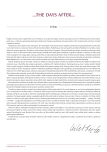Aerobic capacity in patients with ischemic heart disease
Authors:
V. Chaloupka
Authors‘ workplace:
Interní kardiologická klinika, FN Brno-Bohunice
Published in:
Kardiol Rev Int Med 2008, 10(3): 92-95
Overview
Maximum oxygen consumption (VO2max) is an important overall indicator of physical performance. It is also referred to as maximum aerobic capacity. Its value depends on age, sex, physical conditi on and can be improved by physical training. The main functional indicator of physiological aging is a reduction in maximum oxygen consumption. The decline in aerobic capacity is not linear but clearly accelerates with increasing age. Accelerated decline in aerobic capacity naturally has important clinical effects. Even a small improvement in aerobic capacity leads to a notice able improvement in prognosis. An increase of 1ml/ kg/ min in the consumpti on of oxygen represents a 9% improvement in prognosis. This is especially important in the case of patients with low pV02 values (<15ml/ kg/ min). Exercise capacity is not only a good prognostic indicator for patients with IHD but also for healthy persons. In both patients and healthy persons exercise capacity is a stronger predictor of increased risk of death than clinical indicators or the presence of risk factors. Managed rehabilitation programmes show an improvement in oxygen consumption of 11– 36% with the best improvement taking place in patients with the worst condition. Increased exercise tolerance is also associated with a significant reduction in fatal and non‑fatal he art attacks. These results also apply for patients with he art failure. Exercise tolerance and aerobic capacity represent an important forecasting indicator of cardiovascular and overall mortality. We should know their values for our patients and try to achieve permanent improvement in them.
Key words:
ischemic heart disease – aerobic capacity – exercise tolerance – rehabilitation
Sources
1. Morrison CA. Using the exercise test to create the exercise prescription. Prim Care 2001; 28: 137–158.
2. Braunwald, E (ed). Heart Disease. A Textbook of Cardiovascular Medicine. 5th edition. W.B. Saunders Company, 1997: 1687–1703.
3. Fitzgerald MD, Tanaka H, Iran ZV et al. Age-related declines in maximal aerobic capacity in regulary exercising vs. sedentary women: A meta-analysis. J Appl Physiol 1997; 83: 160–165.
4. Wilson TM, Tanaka H. Meta-analysis of the age-associated decline in maximal aerobic capacity in men: relation to training status. Am J Physiol Heart Circ Physiol 2000; 278: H829–H834.
5. Fleg JL, Morrell CH, Bos AG et al. Accelerated Longitudinal Decline of Aerobic Capacity in Healthy Older Adults. Circulation 2005; 112: 674–682.
6. Kavanagh T, Mertens DJ, Hamm LF et al. Prediction of Long-Term Prognosis in 12 169 Men Referred for Cardiac Rehabilitation. Circulation 2002; 106: 667–671.
7. Dorn J, Naughton J, Imamura D et al. Results of a multicenter randomized clinical trial of exercise and long-term survival in myocardial infarction patients: the National Exercise and Heart Disease Project (NEHDP). Circulation 1999; 100: 1764–1769.
8. Myers J, Prakash M, Froelicher V et al. Exercise capacity and mortality among men reffered for exercise testing. N Engl J Med 2002; 346: 793–801.
9. Dutcher JR, Kahn J, Grines C et al. Comparison of left ventricular ejection fraction and exercise capacity as predictors of two- and five-year mortality following acute myocardial infarction. Am J Cardiol 2007; 99: 436–441.
10. Ades PA, Savage PD, Brawner CA et al. Aerobic Capacity in Patients Entering Cardiac Rehabilitation. Circulation 2006; 113: 2706–2712.
11. Ades PA. Cardiac rehabilitation and secondary prevention of coronary heart disease. N Eng J Med 2001; 345: 892–902.
12. Mark DB, Lauer MS. Exercise capacity: the prognostic variable that doesn´t get enough respect. Circulation 2003; 108: 1534–1536.
13. Smart N, Marwick TH. Exercise training for patients with heart failure: a systematic review of factors that improve mortality and morbidity. Am J Med 2004; 116: 693–706.
14. Chaloupka V, Elbl L, Nehyba S et al. Exercise Intensity Prescription After Myocardial Infarction in Patients Treated With Betablockers. J Cardiopulm Rehabil 2005; 25: 361–365.
15. Chaloupka V, Siegelová J, Špinarová L et al. Rehabilitace u nemocných s kardiovaskulárním onemocněním. Doporučené postupy ČKS. Cor et Vasa 2006; 48: K127-K145.
16. Schiffer T, Knicker A, Hofman U et al. Physiological response to nordic walking, walking and jogging. Eur J Appl Physiol 2006; 98: 56-61.
17. Fletcher GF, Balady GJ, Amsterdam EA et al. Exercise standards for testing and training: a statement for healthcare professionals from the American Heart Association. Circulation 2001; 104: 1694-1740.
Labels
Paediatric cardiology Internal medicine Cardiac surgery CardiologyArticle was published in
Cardiology Review

2008 Issue 3
Most read in this issue
- Heart failure with normal ejection fraction
- Catheter ablation of atrial fibrillation
- Comparison of differences between male and female patients with acute myocardial infarction
- Aerobic capacity in patients with ischemic heart disease
